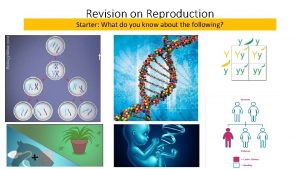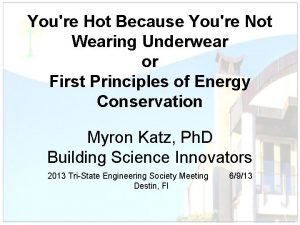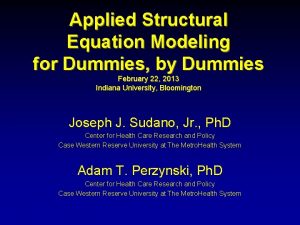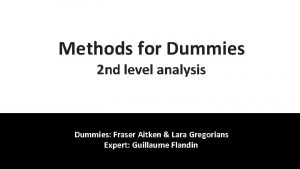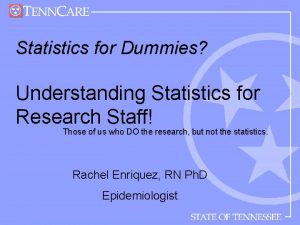Statistics for Dummies Workshop Youre not really Dummies












- Slides: 12

Statistics for Dummies Workshop **You’re not really Dummies**

Before Starting • Disclaimer: We can’t teach a whole quarter of statistics, but we can teach you how to study. Studying for statistics requires reading the book! • If you are not reading on your own and just taking notes in class, you are likely not to succeed • Upper Level classes will automatically assume you have learned to study the material • DO NOT Chegg or Google the solutions

What’s going to be covered • Diagrams • Data Summary and Presentation • Binomial distribution • Engineering/Statistics Toolbox • Z-test • Type 2 Error • T-test • C 2 Test

Dot Diagram Box Plot Q 1 Q 2 Q 3 x = 1550 1. 5 IQR IQR = Inter Quartile Range 1. 5 IQR 1030 1040 1050 1060 1070 1080

Histogram Frequency Cumulative Frequency 25 70 60 20 50 15 40 30 10 20 5 10 0 20 30 40 50 60 70 80

Data Summary Stem and Leaf Diagram Correlation Coefficient n R= S i=1 (xi – x)(yi – y) n (S )( S n i=1 (xi – x)2 i=1 ) (yi – y)2 Stem 1 2 3 4 5 7 8 Leaf 3 245 36814 4624563 5252 4 Freq. 1 3 5 7 4 0 1 Quartile/Percentile Calculation Quartile 1 st (n + 1) 4 2 nd 2(n + 1) 4 3 rd 3(n + 1) 4 Percentile 5 th . 05(n + 1) 95 th . 95(n + 1) Value will give ordered observation Interpolate as needed

Binomial Distribution P(X = x) = ( ) p (1 -p) n! ( ) = x!(n – x)! n x x n-x We use Binomial Distribution when: 1. Trials are independent 2. Each trial results in one of two possible outcomes, success or failure ooooh! 3. The probability, p, remains constant

Engineering/Statistics Toolbox • Known as the procedure for hypothesis testing Steps for Generic Hypothesis Testing • • • 1. Identify Parameter Of Interest: • For instance; determine the saltiness of a potato chips 2. State the Null Hypothesis (H 0): • Standard that you are testing against, like the given average students test scores 3. Alternative Hypothesis (H 1): • Specify an appropriate alternative hypothesis 4. Test Statistic • Equation you are going to use for each test. Z = X-m/(s/n^. 5) 6. Computations • Plug and chug 7. Conclusion • Decide whether the Null Hypothesis should be rejected and report and that in the problem context.

Z-Test • When do you use it? • • Known mean and known variance Gives the probability density of when something is going to happen • Most of the time an alpha value will be given to you • If not, assume 0. 05

Type II Error • • When you fail to reject the null hypothesis when it is wrong then you have committed a type II error b = f(Z 0) Power = 1 - b For instance: Say you have a pop. of 50 beads with an average diameter of 10 mm (actual average diameter). However, your sample of 10 beads has an average of 15 mm. You want to confirm that a null hypothesis of 15 inches is correct. If you fail to reject the null you messed up.

T-Test • Unknown variance and known mean • You need to determine the sample variance • You need to know degrees of freedom • That will be n-1, (n is the sample size) • Literally the same as the Z-test except with degrees of freedom and sample variance

C 2 -Test • This is a test on the sample variance • Much the same as T-test • Must know the sample variance, as well as the actual variance • This tests variance, NOT standard deviation
 Im ok youre not ok
Im ok youre not ok Gravity for dummies and dummies for gravity equations
Gravity for dummies and dummies for gravity equations Remains simon armitage poem
Remains simon armitage poem Bart simpson tin foil hat
Bart simpson tin foil hat How to write email to company
How to write email to company What to do when youre angry
What to do when youre angry I hope you are doing well formal
I hope you are doing well formal You are my firm foundation the rock on which i stand
You are my firm foundation the rock on which i stand You're so random
You're so random My master my king season 3
My master my king season 3 I dont know where youre going
I dont know where youre going What are the signs of an asexual person
What are the signs of an asexual person If love is the answer youre wrong
If love is the answer youre wrong











